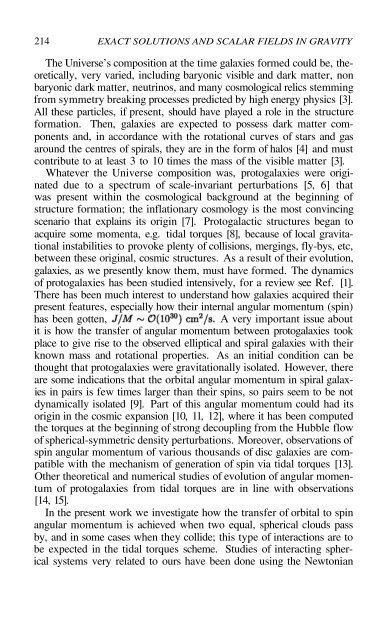Exact Solutions and Scalar Fields in Gravity - Instituto Avanzado de ...
Exact Solutions and Scalar Fields in Gravity - Instituto Avanzado de ...
Exact Solutions and Scalar Fields in Gravity - Instituto Avanzado de ...
You also want an ePaper? Increase the reach of your titles
YUMPU automatically turns print PDFs into web optimized ePapers that Google loves.
214 EXACT SOLUTIONS AND SCALAR FIELDS IN GRAVITY<br />
The Universe’s composition at the time galaxies formed could be, theoretically,<br />
very varied, <strong>in</strong>clud<strong>in</strong>g baryonic visible <strong>and</strong> dark matter, non<br />
baryonic dark matter, neutr<strong>in</strong>os, <strong>and</strong> many cosmological relics stemm<strong>in</strong>g<br />
from symmetry break<strong>in</strong>g processes predicted by high energy physics [3].<br />
All these particles, if present, should have played a role <strong>in</strong> the structure<br />
formation. Then, galaxies are expected to possess dark matter components<br />
<strong>and</strong>, <strong>in</strong> accordance with the rotational curves of stars <strong>and</strong> gas<br />
around the centres of spirals, they are <strong>in</strong> the form of halos [4] <strong>and</strong> must<br />
contribute to at least 3 to 10 times the mass of the visible matter [3].<br />
Whatever the Universe composition was, protogalaxies were orig<strong>in</strong>ated<br />
due to a spectrum of scale-<strong>in</strong>variant perturbations [5, 6] that<br />
was present with<strong>in</strong> the cosmological background at the beg<strong>in</strong>n<strong>in</strong>g of<br />
structure formation; the <strong>in</strong>flationary cosmology is the most conv<strong>in</strong>c<strong>in</strong>g<br />
scenario that expla<strong>in</strong>s its orig<strong>in</strong> [7]. Protogalactic structures began to<br />
acquire some momenta, e.g. tidal torques [8], because of local gravitational<br />
<strong>in</strong>stabilities to provoke plenty of collisions, merg<strong>in</strong>gs, fly-bys, etc,<br />
between these orig<strong>in</strong>al, cosmic structures. As a result of their evolution,<br />
galaxies, as we presently know them, must have formed. The dynamics<br />
of protogalaxies has been studied <strong>in</strong>tensively, for a review see Ref. [1].<br />
There has been much <strong>in</strong>terest to un<strong>de</strong>rst<strong>and</strong> how galaxies acquired their<br />
present features, especially how their <strong>in</strong>ternal angular momentum (sp<strong>in</strong>)<br />
has been gotten, A very important issue about<br />
it is how the transfer of angular momentum between protogalaxies took<br />
place to give rise to the observed elliptical <strong>and</strong> spiral galaxies with their<br />
known mass <strong>and</strong> rotational properties. As an <strong>in</strong>itial condition can be<br />
thought that protogalaxies were gravitationally isolated. However, there<br />
are some <strong>in</strong>dications that the orbital angular momentum <strong>in</strong> spiral galaxies<br />
<strong>in</strong> pairs is few times larger than their sp<strong>in</strong>s, so pairs seem to be not<br />
dynamically isolated [9]. Part of this angular momentum could had its<br />
orig<strong>in</strong> <strong>in</strong> the cosmic expansion [10, 11, 12], where it has been computed<br />
the torques at the beg<strong>in</strong>n<strong>in</strong>g of strong <strong>de</strong>coupl<strong>in</strong>g from the Hubble flow<br />
of spherical-symmetric <strong>de</strong>nsity perturbations. Moreover, observations of<br />
sp<strong>in</strong> angular momentum of various thous<strong>and</strong>s of disc galaxies are compatible<br />
with the mechanism of generation of sp<strong>in</strong> via tidal torques [13].<br />
Other theoretical <strong>and</strong> numerical studies of evolution of angular momentum<br />
of protogalaxies from tidal torques are <strong>in</strong> l<strong>in</strong>e with observations<br />
[14, 15].<br />
In the present work we <strong>in</strong>vestigate how the transfer of orbital to sp<strong>in</strong><br />
angular momentum is achieved when two equal, spherical clouds pass<br />
by, <strong>and</strong> <strong>in</strong> some cases when they colli<strong>de</strong>; this type of <strong>in</strong>teractions are to<br />
be expected <strong>in</strong> the tidal torques scheme. Studies of <strong>in</strong>teract<strong>in</strong>g spherical<br />
systems very related to ours have been done us<strong>in</strong>g the Newtonian

















